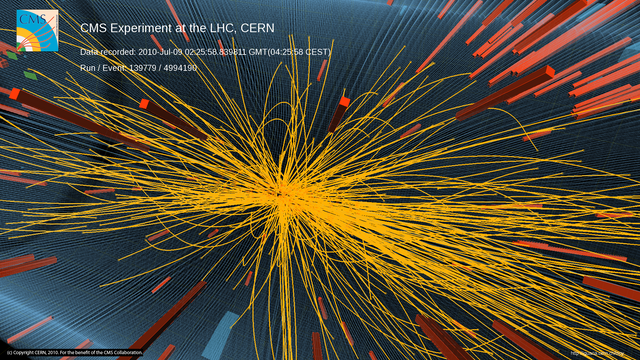Energies in the LHC
I wrote this blog a few years ago on Physics Forums (note, as of 20th May 2015, the LHC has accomplished collisions of 13 Tev).

Image source: CERN
The Large Hadron Collider has produced collisions at 7 TeV. For collisions at 7 TeV, protons need to be ‘ramped’ to 3.5 TeV, the proton has a mass of 1.6726e−27 kg which, according to mass–energy equivalence (E=mc2), is 938.272 MeV where 1 eV= 1.6022e−19 Joules. The proton will be accelerated to 0.999999964c (11,103.4 revolutions of the LHC per second) which means the following relativistic equation can be used-
ET= γmc2
where ET is energy total, γ=1/√(1-(v2/c2)), m is the mass of the proton and c is the speed of light. γ is the Lorentz factor and tells us how much the energy of an object increases due to kinetic energy.
which produces a total of ET=3.4967 TeV
This is also supported by Einstein’s more complete mass-energy equation-
ET=√(m2c4+p2c2)
where p is momentum and is expressed p=γmv (or p=h/λ in the case of light where h is Planck’s constant and λ is wavelength).
which produces a total of ET=3.4967 TeV
CERN hope to conduct collisions at 14 TeV which would require speeds of up to 0.999999991c (1-8.98e−9c)
Another interesting aspect is the effect on time for the proton. The relativistic equation for time dilation is-
dτ=dt/γ
where dτ is change in proper time relative to the proton and dt is change in coordinate time, or time according to a (relatively) static frame. In this case, at energies of 3.5 Tev, the time dilation for the proton is 2.6833e−4 which means for every hour that passes outside the accelerator, only 1 second passes for the proton (0.966 seconds), at 7 TeV, only ½ a second would pass (0.483 seconds). The application of the Lorentz factor to time dilation can be supported by looking at a basic spacetime metric derived from Minkowski space time, accordingly-
c2dτ2=c2dt2-dx2
again, where dτ is the change in proper time of the moving object, dt is the change in coordinate time and dx is the change in distance covered. dx can be rewritten as-
dx2=v2dt2
where v=dx/dt (i.e. velocity is m/s), v2=dx2/dt2 which can be rewritten as above. The spacetime metric can now be written as-
c2dτ2=c2dt2-v2dt2
dτ2=(c2dt2-v2dt2)/c2
dτ=√((c2dt2-v2dt2)/c2)
=√(dt2(1-v2/c2))
= dt√(1-v2/c2)
which is equivalent to dτ=dt/γ.
Time dilation for relativistic sub-atomic particles is also supported by muons (high energy leptons) which are produced high in the atmosphere by cosmic ray interactions, according to our clocks, the muon should decay at approx. 660 m into the atmosphere based on a life span of 2.2e−6 seconds and a velocity of 0.9996678c but due to time dilation (τ=0.02577), muons survive the flight to earth's surface and can penetrate tens of meters of rock before decaying.